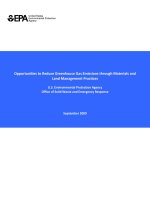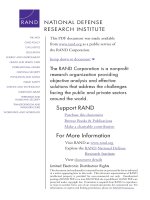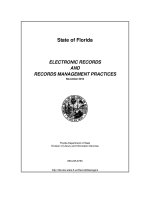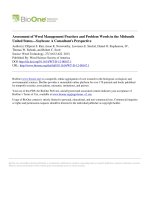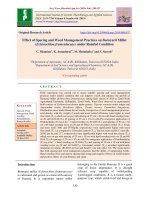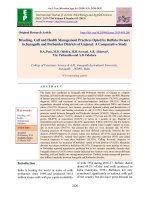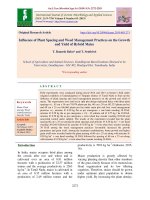Changes in soil microbial population and enzymatic activity under different plant growth-promoting rhizobacteria and weed management practices in direct-seeded upland rice
Bạn đang xem bản rút gọn của tài liệu. Xem và tải ngay bản đầy đủ của tài liệu tại đây (203.74 KB, 7 trang )
Int.J.Curr.Microbiol.App.Sci (2020) 9(8): 3136-3142
International Journal of Current Microbiology and Applied Sciences
ISSN: 2319-7706 Volume 9 Number 8 (2020)
Journal homepage:
Original Research Article
/>
Changes in Soil Microbial Population and Enzymatic Activity under
Different Plant Growth-Promoting Rhizobacteria and Weed Management
Practices in Direct-Seeded Upland Rice
Jimni Phukan*, Jayanta Deka and Sontara Kalita
Department of Agronomy, College of Agriculture, Assam Agricultural University,
Jorhat-785013 (Assam), India
*Corresponding author
ABSTRACT
Keywords
Direct-seeded
upland rice, Plant
growth-promoting
rhizobacteria,
Pretilachlor,
Pseudomonas
fluorescens,
Bacillus cereus,
Phosphomonoesterace activity,
Dehydrogenase
activity
Article Info
Accepted:
24 July 2020
Available Online:
10 August 2020
A field experiment was carried out at Assam Agricultural University, Jorhat (Assam)
in direct seeded rice (DSR) during autumn, 2018. The treatments consisted of three
Plant growth-promoting rhizobacteria (PGPR) inoculations viz., Bacillus cereus,
Pseudomonas fluorescens and no inoculation and four weed management practices
viz., pretilachlor pre-emergence @ 0.75 kg/ha, pretilachlor pre- emergence @ 0.75
kg/ha followed by one hand weeding at 30 DAS, three hand weedings at 15, 30 & 45
DAS and weedy check. Results revealed that higher bacterial population was due to
inoculation of Pseudomonas fluorescens which was followed by Bacillus cereus, but
fungal population was found higher with the inoculation of Bacillus cereus followed
by Pseudomonas fluorescens. Bacterial and fungal population and enzymatic activity
decreased significantly due to either sole application of pretilachlor or in combination
with hand weeding compared to three hand weeding and weedy check. The
phosphomonoesterace and dehydrogenase activity were significantly higher with
Pseudomonas fluorescens followed by Bacillus cereus. Grain and straw yield of DSR
were higher with Pseudomonas fluorescens followed by Bacillus cereus and among
weed management practices, it was higher with three hand weedings which was
followed by pretilachlor pre-emergence @ 0.75 kg/ha + one hand weeding at 30 DAS.
Introduction
Rice (Oryza sativa L.) is the staple food for
more than 50% of the global population. India
has the largest area under rice crop and
ranked second in production next to China.
Though direct-seeding of rice serves several
advantages i.e. saves labour, early crop
maturity, less water requirement and low
production cost etc., but weeds are the major
threat to the production and adoption of DSR
systems.
Hence, successful weed control is essential
for obtaining optimum yield of rice. Sole
application of pre-emergence herbicide alone
cannot give a weed-free environment during
the critical growth period of upland DSR.
3136
Int.J.Curr.Microbiol.App.Sci (2020) 9(8): 3136-3142
Therefore, integrated weed management is
essential for effective weed management and
yield improvement in DSR.
The microbial community plays a critical role
in regulating various soil processes such as
decomposition of organic matter and nutrient
cycling, so there is a keen interest in
understanding the factors that regulate its size,
activity and structure (Zeller et al., 2001).
PGPR are the root colonizing bacteria that
produces beneficial effects on the growth of
the host plant via direct or indirect
mechanisms (Patel and Minocheherhomji,
2018) including nitrogen fixation, nutrient
solubilisation, biosynthesis of phytohormone,
siderophore, antibiotics, hydrolytic enzymes,
exo-polysaccharide and induced systemic
resistance in plants to their pathogen (Gupta
et al., 2015). Improved growth and vigour of
the crop might help in suppressing the
associated weeds by an indirect way.
External application of xenobiotics may lead
to variations in soil enzymatic activities. Soil
enzymes are a group of enzymes usually
present in soil that are continuously playing
an important role in maintaining soil ecology
and thus soil fertility and health. But
herbicide application can alter growth of
microorganisms, thereby soil enzymatic
activities (Monkiedje et al., 2007). Types of
herbicides,
concentration,
method
of
application, nature of the soil, environmental
conditions etc affect the activities of enzymes
in paddy soil.
Besides the type of soil and agricultural
practices, soil enzymatic activities depend on
the physico-chemical properties and quantity
of the pesticide applied (Ramudu et al.,
2011). So, keeping in view the above
problems, this study was conducted with the
objective of studying the performance of plant
growth-promoting rhizobacteria and weed
management on soil biology and yield of rice.
Materials and Methods
A field study was conducted during autumn,
2018 at Instructional-Cum-Research farm
(ICR) of Assam Agricultural University,
Jorhat (Assam). The soil of the experimental
site was sandy loam in texture, acidic in
reaction (pH: 5.5), medium in organic carbon
(0.54%), low in available N (191 kg/ha), P2O5
(22.28 kg/ha) and K2O (107.05 kg/ha). Seeds
of rice variety ‘Inglongkiri’ @75 kg/ha were
sown in rows 20 cm apart in individual plots
of 4m x 3 m size. Crop was applied with
40:20:20 of N:P2O5:K2O kg/ha following the
package of practices. The experiment was laid
out in factorial randomized block design with
three replications. The treatments consisted of
three PGPR inoculations viz., Bacillus cereus,
Pseudomonas fluorescens and no inoculation
and four weed management practices viz.,
pretilachlor pre-emergence @ 0.75 kg/ha,
pretilachlor pre- emergence @ 0.75 kg/ha
followed by one hand weeding at 30 DAS,
three hand weedings at 15, 30 & 45 DAS and
weedy check.
The classical serial dilution technique was
used for isolation of total bacterial and fungal
population from soil by spread plate
technique on appropriate media. Nutrient agar
was used for counting total bacterial
population, while Rose Bengal media was
used for enumeration of fungal population.
Antibiotic Streptomycillin sulphate was added
in the melted media (45ᴏC) before plating.
Aliquots of 100 µl of 10-3 and 10-6 dilution
were spread over the solidified media in
triplicates. Nutrient agar and Rose Bengal
media plates were incubated at 30ᴏC for 2
days. The microbial number was estimated as
log colony forming unit (cfu)/g soil on dry
weight basis. The method of Tabatabi and
Bremner (1969) was followed to estimate the
Phosphomonoesterase (PMEase) activity.
Dehydrogenase activity was determined by
the reduction of triphenyl tetrazolium chloride
(TTC) to triphenyl formazon (TPF) as
3137
Int.J.Curr.Microbiol.App.Sci (2020) 9(8): 3136-3142
described by Casida et al., (1964) with
modifications. The grain and straw yield were
recorded after harvest and sun dried for 3
days. Harvest index was calculated using
standard formula.
All the data pertaining to the present
investigation
wherever
needed
were
statistically analysed. Critical differences
(CD) at 5 per cent probability level was
calculated only when the F value was found
out to be significant.
Results and Discussion
Bacterial and fungal populations
The
bacterial
population
increased
significantly due
to
inoculation
of
Pseudomonas fluorescens
which was
followed by Bacillus cereus, but significantly
higher fungal population was found with the
inoculation of Bacillus cereus followed by
Pseudomonas fluorescens as compared to no
inoculation (Table 1). This might be due to
multiplication of PGPR under favourable
climatic condition or phytohormone released
by the plants.
Among the weed management practices, the
bacterial and fungal population decreased
significantly at 60 DAS due to treatment with
pretilachlor compared to three hand weedings
and weedy check (Table 1). This could be due
to the herbicide activity in the soil which
could
hamper
the
proliferation
of
microorganisms. Sahoo et al., (2016) reported
that microbial population may be affected by
herbicide application at recommended dose.
Interaction of Pseudomonas fluorescens with
three hand weedings at 15, 30 and 45 DAS
resulted in significantly higher bacterial
population as compared to rest of the
treatment combinations which might be due
to absence of herbicide activity (Table 1A).
Enzymatic activities
The phosphomonoesterace and dehydrogenase activity were significantly higher with
Pseudomonas fluorescens followed by
Bacillus cereus compared to no inoculation
(Table 1). Higher microbial population may
lead to more microbial activity in soil which
ultimately enhanced enzymes in soil.
Among the weed management practices,
application of pretilachlor resulted lower
enzymatic activities as compared to hand
weedings and weedy check (Table 1). The
inhibition of growth of most of the
microorganisms due to herbicide activity
might have led to decrease in production of
phosphomonoesterace and dehydrogenase
activities. Similar findings were reported by
Latha and Gopal (2010).
Interaction of Pseudomonas fluorescens with
both three hand weedings at 15, 30 and 45
DAS and weedy check as well as Bacillus
cereus with three hand weedings and weedy
check
resulted
in
higher
phosphomonoesterace and dehydrogenase
activity compared to rest of the treatment
combinations (Table 1A). This might be due
to enhanced microbial activity under this
treatment combination in absence of
herbicidal effect on microbial population.
Grain and straw yield
Grain and straw yield of rice increased
significantly due to Pseudomonas fluorescens
inoculation as compared to other PGPR
inoculation (Table 2) which might be due to
increased availability of nitrogen and
phosphorous as well as higher amount of
cytokinin, gibberelin and auxin leading to
better grain and straw yield (Jambhulkar and
Sharma, 2013).
3138
Int.J.Curr.Microbiol.App.Sci (2020) 9(8): 3136-3142
Table.1 Effect of PGPR and weed management on microbial population and enzyme activity
Treatment
PGPR
Bacillus cereus
Pseudomonas
fluorescens
No inoculation
SEM (±)
CD (P=0.05)
Weed Management
Pretilachlor @ 0.75 kg/ha
Pretilachlor @ 0.75 kg/ha
+ one hand weeding at
30 DAS
Three hand weedings at
15, 30 and 45 DAS
Weedy check
SEM (±)
CD (P=0.05)
Interaction (P × W)
SEM (±)
CD (P=0.05)
Bacterial
population
(-log x 10-5 cfu g-1
soil)
60 DAS
Fungal population
(-log x 10-5 cfu g-1 soil)
60 DAS
60 DAS
At harvest
60 DAS
At harvest
7.98
8.07
7.29
7.23
152.34
161.37
126.30
138.48
149.05
169.62
127.70
144.03
7.93
0.01
0.03
7.16
0.02
0.05
114.76
1.93
5.67
113.85
0.85
2.48
129.32
0.35
1.03
92.77
0.10
0.30
7.93
7.92
7.20
7.17
121.85
126.38
120.85
118.34
130.87
131.81
110.50
110.61
8.07
7.24
159.87
132.01
167.38
132.38
8.05
0.01
0.04
7.29
0.02
0.06
163.21
2.23
6.55
133.65
0.98
2.86
167.24
0.41
1.19
132.51
0.10
0.30
0.02
0.06
0.04
NS
3.87
11.35
1.69
NS
0.71
2.07
0.20
0.59
3139
Phosphomonoesterace activity
(µg p-nitrophenol g-1 dry soil hr-1)
Dehydrogenase activity
(µg TPF g dry soil-1 7 days-1)
Int.J.Curr.Microbiol.App.Sci (2020) 9(8): 3136-3142
Table.1A Interaction effect of PGPR and weed management on bacterial population,
phosphomonoesterace and dehydrogenase activity
Weed
management
W1
W2
W3
W4
SEM(±)
CD (P=0.05)
Bacterial population
P1
7.91
7.93
8.05
8.03
P2
7.97
8.01
8.19
8.10
0.02
0.06
P3
7.89
7.84
7.98
8.02
Phosphomonoesterace
activity (60 DAS)
P1
P2
P3
128.16
130.85
106.53
129.62
133.67
115.86
172.07
186.62
120.92
179.52
194.36
115.75
3.87
11.35
PGPR
dehydrogenase activity ( 60 DAS)
P1
129.00
132.95
167.46
166.77
P2
147.10
152.05
189.71
189.63
0.71
2.07
P3
116.51
110.44
144.98
145.34
dehydrogenase activity (harvest)
P1
116.27
120.08
137.35
137.10
P2
129.62
131.47
157.37
157.68
0.20
0.59
P3
85.62
80.28
102.43
102.75
W1: Pretilachlor @ 0.75 kg/ha, W2: Pretilachlor @ 0.75 kg/ha + one hand weeding at 30 DAS, W3: Three hand weedings at 15, 30 and 45 DAS, W4: Weedy check, P1: Bacillus cereus,
P2: Pseudomonas fluorescens, P3: No inoculation
Table.2 Effect of PGPR and weed management on grain yield, straw yield and harvest index
Treatment
PGPR
Bacillus cereus
Pseudomonas fluorescens
No inoculation
SEM (±)
CD (P=0.05)
Weed Management
Pretilachlor @ 0.75 kg/ha
Pretilachlor @ 0.75 kg/ha + one hand weeding at 30 DAS
Three hand weedings at 15, 30 and 45 DAS
Weedy check
SEM (±)
CD (P=0.05)
Interaction (P × W)
SEM (±)
CD (P=0.05)
Grain yield (q/ha)
Straw yield (q/ha)
Harvest index (%)
13.91
16.63
11.50
0.44
1.28
18.24
21.44
15.52
0.54
1.59
43.3
43.7
42.6
-
10.69
18.84
20.48
6.04
0.50
1.47
16.49
21.92
23.76
11.43
0.62
1.83
39.3
46.2
46.3
34.6
-
0.87
2.55
1.08
3.17
-
3140
Int.J.Curr.Microbiol.App.Sci (2020) 9(8): 3136-3142
Table.3 Interaction effect of PGPR and weed management on grain and straw yield
Weed management
W1
W2
W3
W4
SEM(±)
CD (P=0.05)
PGPR
Grain yield (q/ha)
P1
P2
P3
9.90
12.63
9.53
18.60
22.00
15.97
22.00
23.60
15.83
5.13
8.33
4.67
0.87
2.55
Straw yield (q/ha)
P1
P2
P3
16.23
17.83
15.40
21.17
26.27
18.33
23.23
29.03
19.00
12.33
12.63
9.33
1.08
3.17
W1: Pretilachlor @ 0.75 kg/ha, W2: Pretilachlor @ 0.75 kg/ha + one hand weeding at 30 DAS, W3: Three hand
weedings at 15, 30 and 45 DAS, W4: Weedy check, P1: Bacillus cereus, P2: Pseudomonas fluorescens, P3: No
inoculation
Among the weed management practices, three
hand weedings at 15, 30 and 45 DAS
recorded significantly higher grain and straw
yield which was followed by pretilachlor @
0.75 kg/ha + one hand weeding at 30 DAS as
compared to single application of Pretilachlor
@ 0.75 kg/ha and weedy check (Table 2).
This might be due to better management of
weeds at critical stages of crop growth under
these two treatments. Similar results were
obtained by Maity and Mukherjee (2011).
The PGPR and weed management treatments
interacted significantly in regards to grain and
straw yield. The highest values were obtained
with the combination of Pseudomonas
fluorescens and three hand weedings at 15, 30
and 45 DAS which was at par with grain and
straw yield achieved from the combination of
Pseudomonas fluorescens and pretilachlor @
0.75 kg/ha + one hand weeding at 30 DAS
(Table. 3).
Harvest index
Inoculation of Pseudomonas fluorescens
resulted highest harvest index (43.7) followed
by Bacillus cereus (43.3) and no inoculation
(42.6) (Table 2). Higher dry matter
accumulation and its efficient mobilization
into grains due to Pseudomonas fluorescens
might have resulted higher harvest index. In
respect of weed management practices, three
hand weedings at 15, 30 and 45 DAS resulted
highest harvest index (46.3) closely followed
by pretilachlor @ 0.75 kg/ha + one hand
weeding at 30 DAS (46.2). A good crop
growth and a better partitioning of the dry
matter to reproductive parts under these
treatments might have caused higher harvest
index.
It was concluded that the bacterial and fungal
populations increased with the inoculation of
PGPR resulting in improved enzymatic
activities in the soil that might increase
nutrient availability to the crop which
ultimately resulted higher yield of rice. The
application of pretilachlor reduced both the
microbial population as well as the enzymatic
activity. So, the higher grain and straw yield
with three hand weedings might be due to
improved crop growth under weed free
conditions. Combination of hand weedings
with Pseudomonas fluorescens resulted in
better soil biological activities as well as yield
of rice.
Acknowledgements
The authors would like to acknowledge the
Assam Agricultural University, Jorhat for
sponsoring the study.
3141
Int.J.Curr.Microbiol.App.Sci (2020) 9(8): 3136-3142
References
Casida, Jr. L.E., Klein, D.A. and Santoro, T.
(1964). Soil dehydrogenase activity.
Soil science. 98(6): 371-376.
Gupta, G., Parihar, S.S., Ahirwar, N.K.,
Snehi, S.K. and Singh V. (2015). Plant
growth
promoting
rhizobacteria
(PGPR): current and future prospects
for
development
of
sustainable
agriculture. Journal of Microbiology
and Biochemical Technology. 7(2):
096-102.
Jambhulkar, P.P. and Sharma, P. (2013).
Promotion of rice seedling growth
characteristics by development and use
of bioformulation of Pseudomonas
fluorescens.
Indian
Journal
of
Agricultural Sciences. 83(2): 136-142.
Latha, P.C. and Gopal, H. (2010). Effect of
Rice Herbicides on β-glucosidase,
Protease and Alkaline Phosphatase
Activity in Soil. Indian Journal of Weed
Science. 42(3&4): 223-225.
Maity, S. K., and Mukherjee, P. K. (2011).
Effect of brown manuring on grain yield
and nutrient use efficiency in dry direct
seeded Kharif rice (Oryza sativa L.).
Indian Journal of Weed Science.
43(1&2): 61-66.
Monkiedje, A., Spiteller, M., Maniepi, S.J.N.
and Sukul, P. (2007). Influence of
metalaxyl-and
mefenoxam-based
fungicides on chemical and biochemical
attributes of soil quality under field
conditions in a southern humid forest
zone of Cameroon. Soil Biology and
Biochemistry. 39(4): 836-842.
Patel, S.T. and Minocheherhomji, F.P. (2018).
Plant Growth Promoting Rhizobacteria:
Blessing to Agriculture. International
Journal of Pure and Applied
Bioscience. 6: 481-492.
Ramudu, A.C., Mohiddin, G.J., Srinivasulu,
M., Madakka, M. and Rangaswamy, V.
(2011).
Impact
of
fungicides
chlorothalonil and propiconazole on
microbial activities in groundnut
(Arachis hypogaea L.) soils. ISRN
microbiology.
Sahoo, S., Adak, T., Bagchi, T.B., Kumar, U.,
Munda, S., Saha, S., Barliner, J.,
Mayabini, J. and Mishra, B.B. (2016).
Non-target effects of pretilachlor on
microbial properties in tropical rice soil.
Environmental Science and Pollution
Research. 23(8): 7595-7602.
Tabatabai, M.A. and Bremner, J.M. (1969).
Use of p-nitrophenyl phosphate for
assay of soil phosphatase activity. Soil
biology and biochemistry. 1(4): 301307.
Zeller, V., Bardgett, R.D., and Tappeiner, U.
(2001). Site and management effects on
soil microbial properties of subalpine
meadows: a study of land abandonment
along a north–south gradient in the
European Alps. Soil Biology and
Biochemistry. 33(4-5): 639-649.
How to cite this article:
Jimni Phukan, Jayanta Deka and Sontara Kalita. 2020. Changes in Soil Microbial Population
and Enzymatic Activity under Different Plant Growth-Promoting Rhizobacteria and Weed
Management Practices in Direct-Seeded Upland Rice. Int.J.Curr.Microbiol.App.Sci. 9(08):
3136-3142. doi: />
3142
